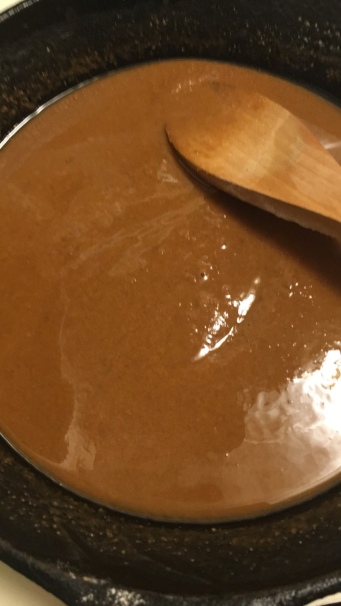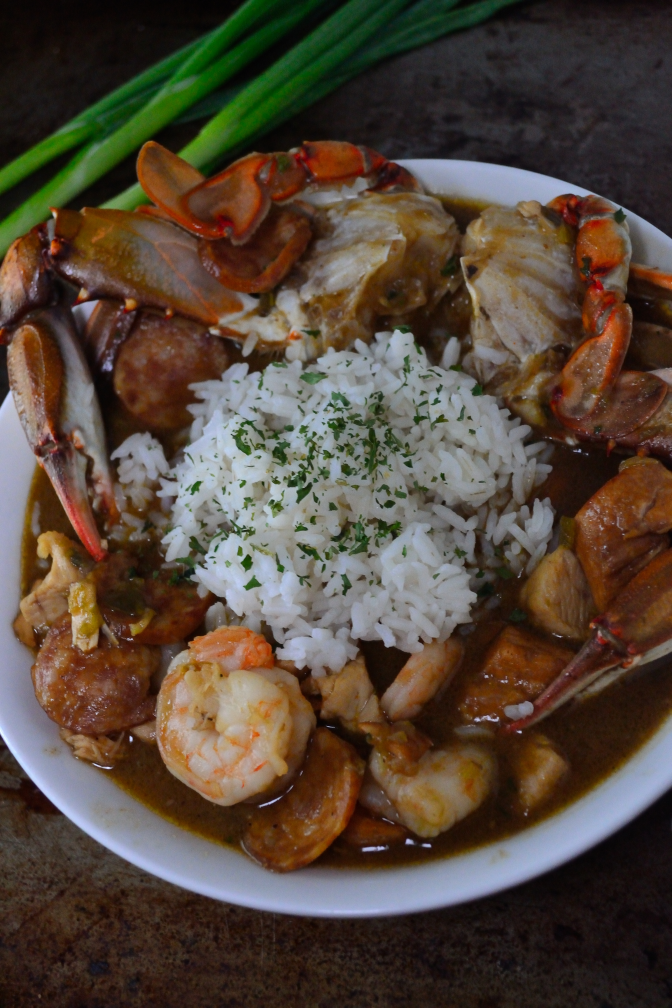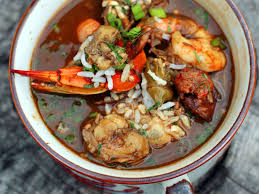Social media has been ablaze with Gumbo posts, pictures, and never-ending comments on “what is put in authentic gumbo to people debating about things that should not go into the gumbo pot, such as boiled eggs. Yesterday I decided to jump on the bandwagon to show and tell them how to cook real New Orleans-style Gumbo on Facebook Live.
Gumbo is a traditional Louisiana dish made with a variety of ingredients such as seafood, meat, okra, and vegetables in a thick roux-based broth. Gumbo has a rich history and cultural significance, and its popularity has spread beyond Louisiana to other parts of the world. In this paper, I will explore the origin, variations, and cultural importance of gumbo.
Origin of Gumbo
Tracing gumbo’s roots is complicated because no African-Americans recorded their recipes in cookbooks until after the Civil War. Though well rooted in Louisiana, gumbo was not a dish unique to that region. Indeed, during the colonial era and the early 19th century, similar okra-based stews and soups could be found anywhere a large number of enslaved Africans, and their descendants lived—and those dishes can still be found there today.
Gumbo is actually a big pot of Gumbo itself because it’s derived of many cultures from all parts of the world, with blended cultures. Gumbo essentially means the blending of several ingredients in one pot with the result of a taste that is deliciously indescribable, as with our people. The dish itself is a mixture of French, German, Italian, and African cooking traditions.
While scholars are relatively uncertain of the exact origin of the food, it is widely accepted that its etymology stemmed from the word okra in West Africa.
New Orleans was established in 1718 and quickly became the first French colony in Louisiana. Soon it became one of the most diverse and culturally rich environments in the United States. Germans migrated there at the beginning of the 18th century and introduced the art of sausage making. Spaniards settled there in the middle of the 18th century and brought with them their love of spices and their fisherman abilities. By the beginning of the 19th century, most families in New Orleans purchased enslaved people who brought okra and hot pepper plants from Africa.
The first known reference to gumbo as a dish was uncovered by historian Gwendolyn Midlo Hall, who found a handwritten transcription of the interrogation of a 50-year-old enslaved person named Comba in New Orleans in 1764. Suspected of being associated with other enslaved people who had stolen clothes and a pig, Comba is asked whether she had given an enslaved person named Louis un gombeau, and she replies that she did.
In several West African languages, the word for okra is ki ngombo, or, in its shortened form, gombo.” Early on, the word was frequently used alongside “okra” by English writers.
In 1817, the American Star of Petersburg, Virginia, ran an article describing okra, which it noted “is common in the West Indies.” It provided two recipes. First, an equal amount of cut okra and tomatoes are stewed with onions, butter, salt and pepper. On the other, okra is stewed in water and dressed with butter. “At St. Domingo,” the writer notes, “they are called gambo.”
Mary Randolph included a similar recipe for “Gumbo—A West India Dish” in The Virginia House-Wife (1824): okra stewed in water and served with melted butter. An 1831 article on okra in the New England Farmer noted the plant’s “known reputation in the West Indies” and that “a very celebrated dish, called Gombo, is prepared in those countries where okra is grown, by mixing with the green pods, ripe tomatoes, and onions; all chopped fine, to which are added pepper and salt, and the whole stewed.” The 1841 edition of Webster’s Dictionary defined gumbo as “A dish of food made of young capsules of ocra, with salt and pepper, stewed and served with melted butter.”
In the mid-19th century, gumbo shifted from being a dish associated with the West Indies to one associated with New Orleans, perhaps thanks to how many cooks and diners of all races had embraced it in Louisiana. The cookbook, Housekeeping in Old Virginia by Marion Carbell Tyree, was published in 1879 and contained the first known gumbo recipe. This gumbo was filé-based and utilized oysters, chicken, spices, and vegetables. Since then, there have been many different recipes for gumbo, which include chicken, seafood, and sausage, and are thickened by pods of okra, roux, and filé powder.
Variations of Gumbo
Gumbo has many variations depending on the location and cooking techniques. Some of the popular gumbo variations are:
1. Seafood gumbo – made with shrimp, crab, and crawfish.
2. Chicken gumbo – made with chicken and andouille sausage.
3. Creole gumbo – this gumbo variation includes tomatoes.
4. Vegan gumbo – replacing meat with vegetables such as mushrooms, eggplant, or tofu.
While some variations retain the traditional combination of okra and roux, others omit these ingredients altogether. Chances are, there is a gumbo recipe out there to cater to all tastes.
Cooking Methods
Traditionally, gumbos have been divided into two large categories—those thickened with okra and those thickened with filé. According to some accounts, before the advent of refrigeration and freezers, okra was the preferred thickening agent for gumbo. At the same time, filé was a substitute used only in the off-season when okra wasn’t available. That sounds plausible, but I’ve also found references to dried okra as an ingredient in 19th-century gumbos. By drying okra, cooks could use it in their gumbos year round.l
Speaking of File’

File‘ in my opinion, is the reason we, New Orleanians, stake claim as the rightful owners of Gumbo, especially “New Orleans Gumbo.” One can not go into any grocery store outside Louisiana to purchase File’. Why is that? File’ is only used in Gumbo here in Louisiana, but if you know of any other recipes calling for File,’ please correct me.
Another theory contends that gumbo originated with Native Americans. That idea draws support from using the ground sassafras called File’powder as a thickening agent in some gumbos. According to this account, File’ was introduced to the French by the Choctaws, whose word for sassafras was kombo. The establishment of New Orleans in 1718 marked the beginning of the French colony of Louisiana. French settlers allied with various native tribes, including the Choctaw, Alabama, and Cherokee, from whom they learned new cooking methods and ways to identify edible indigenous plants.
We can agree that the Natives were here first. Therefore with the use of File’ being noted in the 1700s, we can safely assume that the Native Tribes of Louisiana could have been the originators.
Recipes for gumbos made with filé started appearing in print just before the Civil War, suggesting that using powdered sassafras as thickener was starting to spread outside of Louisiana. The Carolina Housewife (1847) includes a recipe for “Okra Soup” made with beef, okra, and tomatoes, as well as one for “New Orleans Gumbo” made with turkey or fowl and onion, to which a hundred oysters and “two teaspoons of pulverized sassafras leaves” are added. A similar chicken-based “Filet gumbo,” thickened with filé powder, appears in Miss Leslie’s New Cookery Book (1857).

Roux
Roux is a mixture of flour and fat cooked together and used to thicken and flavor sauces, stews, gumbo, etc. Roux is typically made from equal parts of flour and fat by weight. *Never use burnt roux as it the foundation of your dish and over cooking it will ruin your entire pot.



The Gumbo Controversy
In some respects, putting gumbo into either an okra or a filé category is still valid. Still, for many cooks, a brown roux is the only thickener, and filé has virtually disappeared from their recipes. Often roux-based gumbos do incorporate filé, and to my taste, they are the better for it. Filé is used both for thickening and for flavor. It is usually added to a gumbo before serving or at the table. Many okra gumbos also incorporate a brown roux, and some roux-based gumbo contains a small amount of okra, often cooked until it virtually dissolves.
If all those variations aren’t confusing enough, there are raging controversies over what constitutes a proper gumbo roux. Roux, of course, is flour that has been browned in oil or some other fat and has its origin in French cuisine.
As I mentioned in my video, I use all three. I start with my roux, which has a very dark caramel color and compliments my three shrimp stocks, chicken, and gizzards. What I do not understand is why most people steer away from making a roux. I have heard various excuses, one being that it takes too much time. Years ago, I recall Emeril said:
” How I judge the right color for the roux for the perfect gumbo. It is two beers, and it’s generally the time it takes to have the perfect roux. And on Sunday, sometimes when I really wanna sprawl myself, I purposely burn the roux to have another two beers and start again.” That doesn’t sound like a long time to me. If you’re not a beer drinker try a glass of wine or a cocktail to help time ease by.
Cultural Importance of Gumbo
Gumbo is more than just a dish; it’s a cultural symbol of Louisiana. It is often served during festivals, such as Mardi Gras, and is a traditional dish served on Christmas eve, where it is known as “Gumbo z’herbes,” featuring only greens instead of meat. Gumbo’s legacy is also reflected in the music, art, and literature of the region. It is no wonder that chefs worldwide have taken on the challenge of perfecting this complex dish with its rich cultural roots.
Gumbo is a well-loved dish throughout the world, renowned for its complex and intense flavors. Its origin dates back several centuries, inspired by African and European cultures that have made Louisiana unique. Its versatility allows for a variety of adaptations while retaining its cultural significance. The history of gumbo is a testament to how food can bring together different cultures and create something truly remarkable. Now that you’ve learned about the history of gumbo, it’s time to cook and experience the taste and soul of this dish.

My Momo Gumbo Recipe:
Ingredients:
Roux
– ½ cup vegetable oil
– ½ cup all-purpose flour
Gumbo
– 1 onion, chopped
– 1 bell pepper, chopped
– 1 celery stalk, chopped
– 4 cloves garlic, minced
– 1 pound andouille sausage, sliced
– 1 pound chicken thighs, boneless and skinless
– 1 tablespoon creole seasoning
– 1 teaspoon dried thyme
– 1 teaspoon smoked paprika
– ½ teaspoon cayenne pepper
– 6 cups chicken, shrimp or crab stock
– 1 tablespoon Worcestershire sauce
– 1 can diced tomatoes
– 2 cups okra, sliced
– 1 bay leaf
– 1 pound shrimp, peeled and deveined
– 1/2 pound lump crabmeat, picked over for shells and cartilage
– Cooked rice, for serving
Instructions:
1. In a large Dutch oven or pot, heat the vegetable oil over medium-high heat. Add the flour and whisk continuously for 10-15 minutes, until you have a dark brown roux.
2. Add the onion, bell pepper, and celery to the pot and cook for 5-7 minutes, until softened.
3. Add the garlic, browned sausage, chicken, creole seasoning, thyme, oregano, smoked paprika, and cayenne pepper to the pot, and cook for an additional 5 minutes.
4. Pour in the stock, Worcestershire sauce and diced tomatoes. Stir to combine.
5. Add the okra and bay leaf to the pot, and bring the mixture to a simmer. Cook for 30 minutes, until the chicken is cooked through and the okra is tender.
6. Add the shrimp and crabmeat to the pot and cook for an additional 5-7 minutes, until the shrimp are pink and cooked through.
7. Season the gumbo with salt and pepper to taste.
8. Serve the gumbo over cooked rice.
